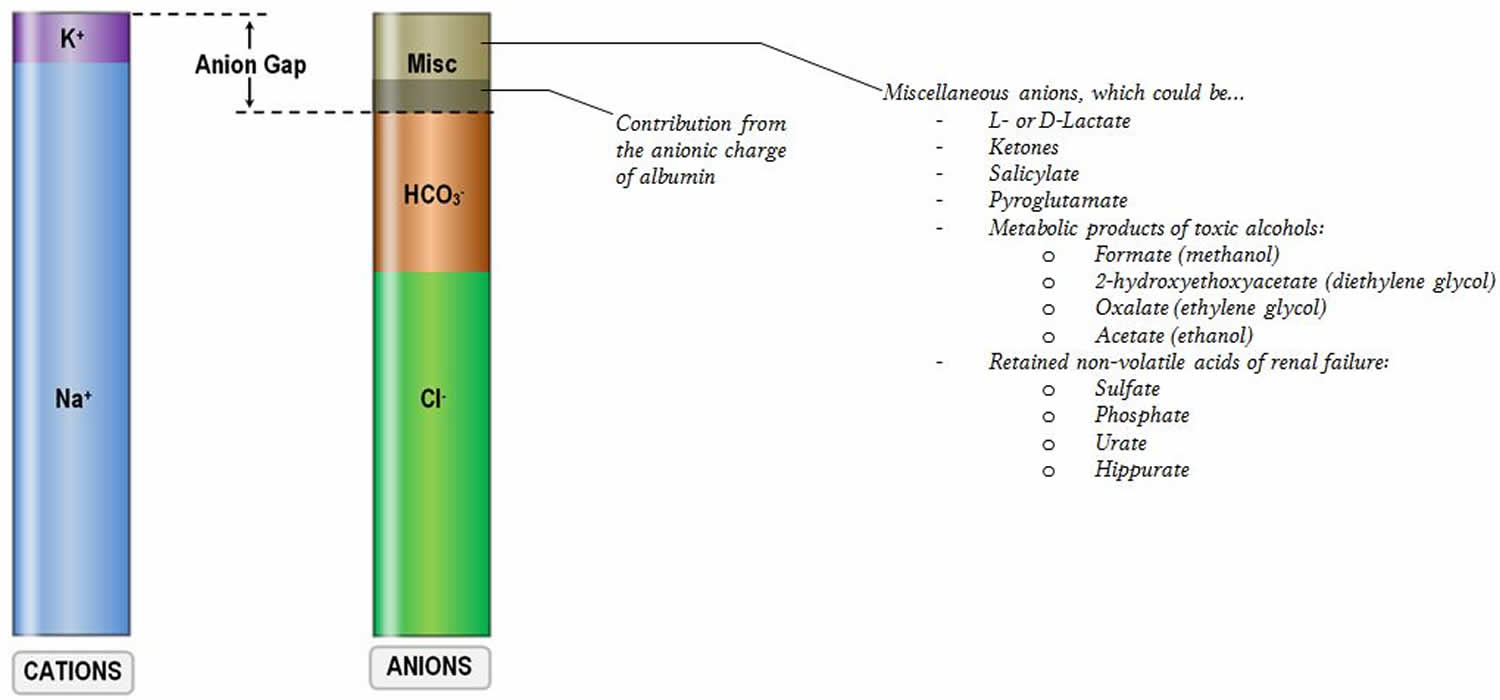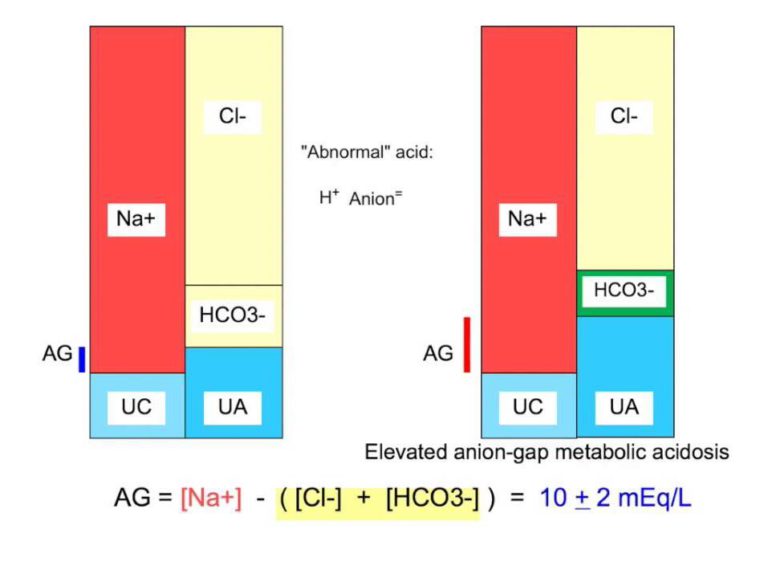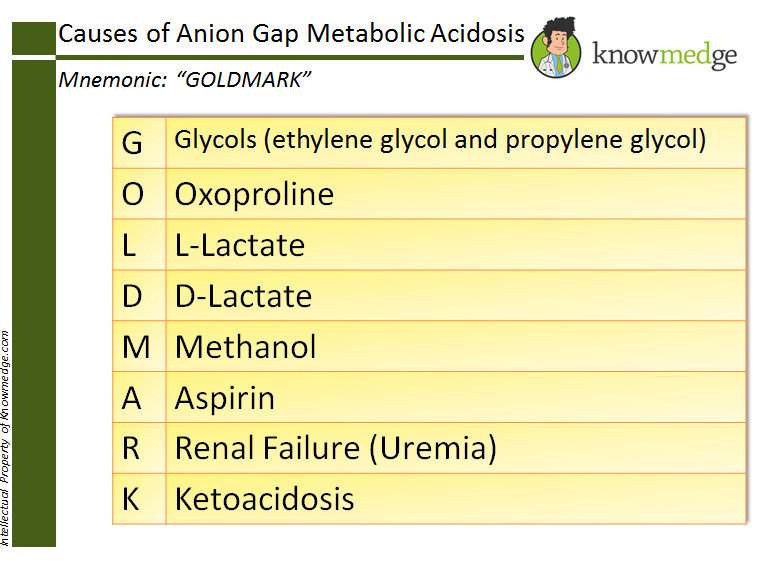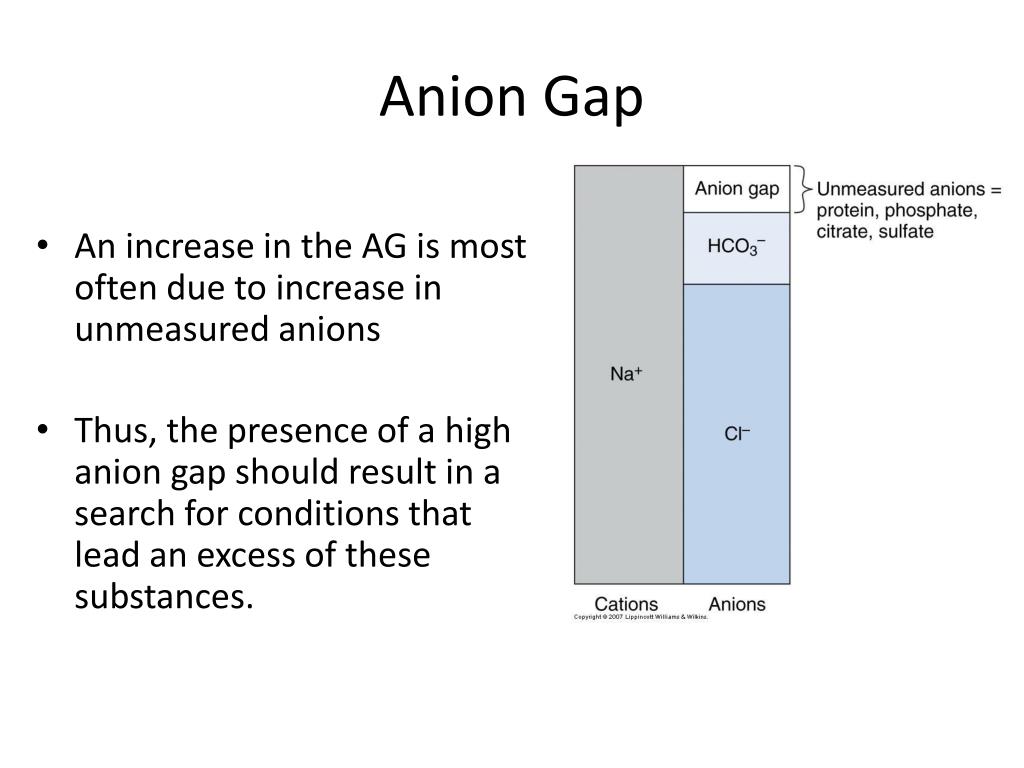
ABG Interpretation The Anion Gap (Lesson 5) YouTube
The anion gap is a measurement of the difference — or gap — between the negatively charged and positively charged electrolytes. Each of the above electrolytes is individually measured in a comprehensive metabolic blood test panel and electrolyte blood test panel. Laboratory scientists then calculate the anion gap based on those measurements.

Skeleton Key Group Case 18 Filling in the Gap Renal Fellow Network
GOLDMARK mnemonic for anion gap metabolic acidosis Glycols (ethylene glycol & propylene glycol) Oxoproline (metabolite of acetaminophen) L-lactate D-lactate (acetaminophen, short bowel syndrome, propylene glycol infusions for lorazepam and phenobarbital) Methanol ASA Renal Failure

anion gap 判讀 Hanxngde
The GOLDMARK mnemonic is helpful in recalling causes of a HAGMA (Table 2).[[5]] Table 2: GOLDMARK mnemonic showing causes for a high anion gap metabolic acidosis.. Diagnosis requires clinical suspicion based on raised anion gap, exclusion of more common causes and the presence of relevant risk factors.[[3]] Formal diagnosis of pyroglutamic.

Normal Anion Gap Metabolic Acidosis Mnemonic
A helpful mnemonic called "GOLDMARK" can be used when evaluating causes of elevated anion gap metabolic acidoses such as in this case [5]. These include glycols (ethylene and propylene.

Anion gap calculation, anion gap blood test & causes of high or low anion gap
A mnemonic to remember the commonest causes of anion gap metabolic acidosis is: GOLDMARK Mnemonic G: glycols (ethylene glycol and propylene glycol) O: oxoproline L: L-lactate D: D-lactate M: methanol A: aspirin R: renal failure K: ketoa.

The anion gap; its merits and demerits Deranged Physiology
GOLD MARK: an anion gap mnemonic for the 21st century. GOLD MARK: an anion gap mnemonic for the 21st century. GOLD MARK: an anion gap mnemonic for the 21st century Lancet. 2008 Sep 13;372(9642):892. doi: 10.1016/S0140-6736(08)61398-7. Authors Ankit N Mehta, Joshua B Emmett, Michael Emmett. PMID:.

The Anion Gap in Metabolic Acidosis YouTube
The acronym GOLDMARK, which was proposed in 2008, is the most frequently used . Based on the clinical presentation and initial laboratory results at time of admission and using the GOLDMARK-acronym, 5-oxoproline and D-lactate were considered as potential causes of the raised anion gap metabolic acidosis.

Dx Schema Anion gap metabolic acidosis The Clinical Problem Solvers
Mnemonic for causes: the mnemonic GOLDMARK replaces the older MUDPILERS and is a more accurate reflection of common modern causes of anion gap acidosis. The starred conditions are the most common causes.. Serum anion gap: its uses and limitations in clinical medicine. Clin J Am Soc Nephrol 2007;2(1):162-74. Kraut JA, Mullins ME. Toxic.

Anion Gap Meaning, Symptoms, Causes, Treatment and More
Anion gap is calculated as (Na - Cl - Bicarb). Nothing fancy, no corrections for anything (glucose, albumin, potassium, etc.). More discussion of the anion gap in the chapter on diagnosing acid/base problems here. Elevated anion gap is concerning, because many causes of this are immediately life-threatening. (Unlike, for example, non-anion.

Anion gap calculation, anion gap blood test & causes of high or low anion gap
the basis of an anion gap calculation (Na+[Cl-HCO 3 -]): the high-anion-gap metabolic acidoses, and the normal-anion-gap, or hyperchloraemic, metabolic acidoses. Two popular mnemonics are often used to remember the major causes of the high-gap metabolic acidoses. The fi rst is KUSMALE (a useful misspelling of Adolph Kussmaul's name), which

Acid Base Disorders Blog of Dr. Agnibho
High anion gap metabolic acidosis is a form of metabolic acidosis characterized by a high anion gap (a medical value based on the concentrations of ions in a patient's serum). Metabolic acidosis occurs when the body produces too much acid, or when the kidneys are not removing enough acid from the body. Several types of metabolic acidosis occur, grouped by their influence on the anion gap.

clinical clerkship mnemonics
A Lancet Editorial1 in 1977, referring to an article entitled "Clinical use of the anion gap"2 opined: "In an age when all too often plasma-electrolyte measurements are ordered without any deliberate judgment being made as to the likely usefulness of the result, it is refreshing to have a reminder of the subtleties involved in the interpretation of this commonest set of clinical.

High Anion Gap Tool Medical mnemonics, Medical laboratory science, Nursing mnemonics
GOLD MARK is a new mnemonic recommended to replace MUDPILES for causes of anion-gap metabolic acidosis. GOLD MARK. G lycols (propylene glycol and ethylene glycol); O xoproline - 5-oxoproline (or pyroglutamic acid) is associated with chronic acetaminophen use, often by malnourished women.; L-lactate,; D-lactate - D-lactic acid can occur in some patients with short bowel syndromes

An Unexpected Gap Effects of Salicylates and Other Conditions on the Serum Anion Gap AJKD Blog
The most common causes of high anion gap metabolic acidosis (HAGMA) are listed in Table 1. They are arranged as the mnemonic "GOLDMARK" (Glycols [ethylene, pro-pylene, and diethylene], 5-Oxoproline [acetaminophen], L-Lactic Acid, D-Lactic acid, Methanol, Aspirin, Renal fail-ure, Ketoacidosis). In contrast, when metabolic acidosis is due to.

Medical Mnemonics Causes of Anion Gap Metabolic Acidosis “GOLD MARK” USMLE / Internal
The GOLDMARK mnemonic for anion gap metabolic acidosis is more useful. GOLDMARK mnemonic for anion gap metabolic acidosis; Glycols (ethylene glycol & propylene glycol) Oxoproline (metabolite of acetaminophen) L-lactate. D-lactate (acetaminophen, short bowel syndrome, propylene glycol infusions for lorazepam and phenobarbital)

PPT Anion Gap PowerPoint Presentation, free download ID2865703
More recently a new mnemonic has been suggested to update new our understanding of anion-gap generating acids. The updated mnemonic "GOLD MARK" was proposed in a 2008 article in The Lancet. G - Glycols (ethylene glycol and propylene glycol) O - Oxoproline; L - L-Lactate; D - D-Lactate; M - Methanol; A - Aspirin; R - Renal Failure